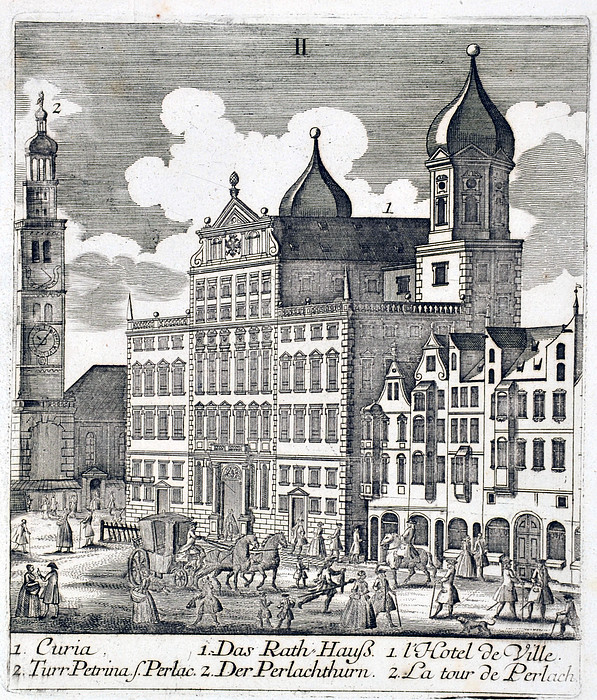|
Goldener Saal
The Goldener Saal (Golden Hall) is a ceremonial room in the 3rd floor of Augsburg Town Hall, which is famous for its ceiling paintings, murals, and golden wall decoration. It was finished in 1643 and is one of the most important cultural monuments of the late Renaissance The Renaissance ( , ) , from , with the same meanings. is a period in European history marking the transition from the Middle Ages to modernity and covering the 15th and 16th centuries, characterized by an effort to revive and surpass ideas .... The room was built after plans by Elias Holl. In 1944, the Town Hall and the Goldener Saal were destroyed by an air raid and were reconstructed in 1996. External links Homepage * Augsburg-Wikientry ---- Individual rooms Architecture in Germany Buildings and structures in Augsburg Renaissance art {{Bavaria-struct-stub ... [...More Info...] [...Related Items...] OR: [Wikipedia] [Google] [Baidu] |
Augsburg Town Hall
The Town Hall of Augsburg (German: ''Augsburger Rathaus'') is the administrative centre of Augsburg, Bavaria, Germany, and one of the most significant secular buildings of the Renaissance style north of the Alps. It was designed and built by Elias Holl, Stadtbaumeister (Master Builder of the town), in 1615–1624. Due to its historic and cultural importance, it is protected by the Hague Convention for the Protection of Cultural Property in the Event of Armed Conflict. Summary On 25 August 1615, the foundation stone of the building was laid by then Stadtbaumeister Elias Holl. The exterior of the building was completed in March 1620, and the interior in 1624. Technologically, the Augsburger Rathaus was a pioneering performance; upon its completion it was the first building in the world with more than six storeys. The rigid elegance of the large stonework was similar to Florence, the cultural and financial capital of Northern Italy, with which the city gladly compared itself. The self- ... [...More Info...] [...Related Items...] OR: [Wikipedia] [Google] [Baidu] |
Renaissance
The Renaissance ( , ) , from , with the same meanings. is a period in European history marking the transition from the Middle Ages to modernity and covering the 15th and 16th centuries, characterized by an effort to revive and surpass ideas and achievements of classical antiquity. It occurred after the Crisis of the Late Middle Ages and was associated with great social change. In addition to the standard periodization, proponents of a "long Renaissance" may put its beginning in the 14th century and its end in the 17th century. The traditional view focuses more on the early modern aspects of the Renaissance and argues that it was a break from the past, but many historians today focus more on its medieval aspects and argue that it was an extension of the Middle Ages. However, the beginnings of the period – the early Renaissance of the 15th century and the Italian Proto-Renaissance from around 1250 or 1300 – overlap considerably with the Late Middle Ages, conventionally da ... [...More Info...] [...Related Items...] OR: [Wikipedia] [Google] [Baidu] |
Individual Rooms
An individual is that which exists as a distinct entity. Individuality (or self-hood) is the state or quality of being an individual; particularly (in the case of humans) of being a person unique from other people and possessing one's own needs or goals, rights and responsibilities. The concept of an individual features in diverse fields, including biology, law, and philosophy. Etymology From the 15th century and earlier (and also today within the fields of statistics and metaphysics) ''individual'' meant " indivisible", typically describing any numerically singular thing, but sometimes meaning "a person". From the 17th century on, ''individual'' has indicated separateness, as in individualism. Law Although individuality and individualism are commonly considered to mature with age/time and experience/wealth, a sane adult human being is usually considered by the state as an "individual person" in law, even if the person denies individual culpability ("I followed instruct ... [...More Info...] [...Related Items...] OR: [Wikipedia] [Google] [Baidu] |
Architecture In Germany
The architecture of Germany has a long, rich and diverse history. Every major European style from Roman to Postmodern is represented, including renowned examples of Carolingian, Romanesque, Gothic, Renaissance, Baroque, Classical, Modern and International Style architecture. Centuries of fragmentation of Germany into principalities and kingdoms caused a great regional diversity and favoured vernacular architecture. This made for a heterogeneous and diverse architectural style, with architecture differing from town to town. While this diversity may still be witnessed in small towns, the devastation of architectural heritage in the larger cities during World War II resulted in extensive rebuilding characterized by simple modernist architecture. In this context, however, it must be emphasized that many German cities had already changed their face in the course of industrialization in the 19th and 20th centuries. Cities like Munich or Berlin (population around 1500: 13000/8000 ... [...More Info...] [...Related Items...] OR: [Wikipedia] [Google] [Baidu] |
Buildings And Structures In Augsburg
A building, or edifice, is an enclosed structure with a roof and walls standing more or less permanently in one place, such as a house or factory (although there's also portable buildings). Buildings come in a variety of sizes, shapes, and functions, and have been adapted throughout history for a wide number of factors, from building materials available, to weather conditions, land prices, ground conditions, specific uses, monument, prestige, and aesthetic reasons. To better understand the term ''building'' compare the list of nonbuilding structures. Buildings serve several societal needs – primarily as shelter from weather, security, living space, privacy, to store belongings, and to comfortably live and work. A building as a shelter represents a physical division of the :Human habitats, human habitat (a place of comfort and safety) and the ''outside'' (a place that at times may be harsh and harmful). Ever since the first cave paintings, buildings have also become objects or ... [...More Info...] [...Related Items...] OR: [Wikipedia] [Google] [Baidu] |
.jpg)




